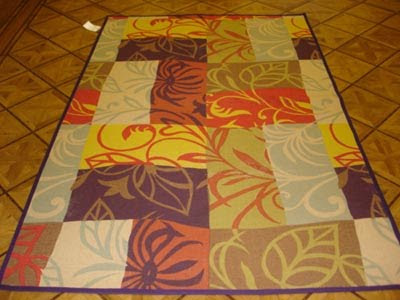 The art of area rug making and the taste for wool area rugs spread across Europe with her contact with Islamic civilization. The earliest European rugs were made in Spain, and some of these pre-date the Muslim invasion. The Synagogue rug, a wool area rug dating from the 14th century, is the earliest extant example of this ancient style. The Armorial carpets, another well-known remnant of this style, has birds and flowers motifs and depictions of Spanish Christian families. This style gave way to the Renaissance style with its silk designs and wreath and pomegranate motifs as the land was re-conquered from the Moors.
The art of area rug making and the taste for wool area rugs spread across Europe with her contact with Islamic civilization. The earliest European rugs were made in Spain, and some of these pre-date the Muslim invasion. The Synagogue rug, a wool area rug dating from the 14th century, is the earliest extant example of this ancient style. The Armorial carpets, another well-known remnant of this style, has birds and flowers motifs and depictions of Spanish Christian families. This style gave way to the Renaissance style with its silk designs and wreath and pomegranate motifs as the land was re-conquered from the Moors.In early seventeenth century, France began producing wool area rugs at Savonnerie in the style of Persian rugs. These were densely ornamented with flowers, and were characterized by architectural framing and mythological scenes. The most famous of these were a set of 105 carpets produced under the direction of Charles Le Brun for the palace at Louvre.
Area rug making came to England in late 16th century AD. The 14 extant specimens are called "Norwich carpets" after the town in Northern England where they were produced. These are adaptations of Oriental rug making, especially of the Indo-Persian art. In the coming centuries, the carpet manufacturers Exeter, Moorfields and Axminster became prominent in England. The heart of English area rug manufacture was at Kiddernminster in Worcestershire, where, to this day, a majority of the population is engaged in the industry.
1791 saw the beginning of area rug manufacturing in the United States with William Sprague's first woven carpet mill in Philadelphia. Other such manufacturers sprung up in New England, and the Beattie Manufacturing Company in New Jersey of that era lasted until 1979.
The revolutionary power loom was invented by Erastus Bigelow in 1839. Area rug making doubled and then tripled in the next few years due to the impact of the power loom. Various enhancements and modifications began to be made, and new companies sprung up based on each such modification. Alexander Smith and sons, which was based on the Skinner powerloom, was founded in 1845 and grew to become the largest manufacturer of area rugs in the world by 1929.
At around the same time, in 1926, Marshall Fields, the well-known Chicago retailer, had a traditional Axminster loom modified to create an unprecedented area rug - a wool rug that was woven through the back like Oriental carpets and with the same sort of color variations as an Oriental. These area rugs were called Karastan rugs, and they are still widely manufactured and fawned upon by carpet-lovers.
Another development took place in Dalton, Northern Georgia, where a young woman named Catherine Evans Whitener invented a new method for weaving wool area rugs - this was called tufting and mainly used for making bedspreads. This became widely popular throughout the US and elsewhere, and Dalton became known as the Bedspread Capital of the World.
Meanwhile, wool area rugs also began to mature as an industry. Various new finishing processes were invented by manufacturers in a bid to give their area rugs a more antique, oriental quality. The creation of a faded, vintage patina, much like the grayed photographs of old days, began to gain a sophistication which made it hard to tell an ancient oriental area rug from a present-day rug manufactured by the likes of Karastan. Using chemical dyes, wool area rugs made in present day USA could be given the same texture and appearance that a fabulously ancient Persian rug using vegetable dye could have. The ancient industry seemed to have come full circle.



No comments:
Post a Comment